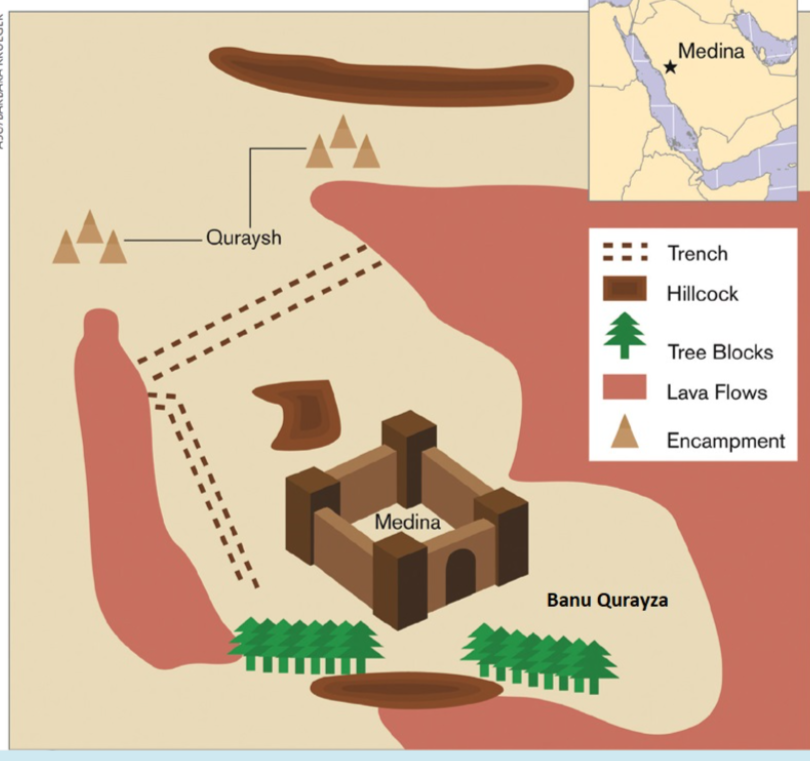Bismillah,
The early years in Madinah were a crucial time for building a united community under the leadership of Prophet Muhammad ﷺ.
One of the most significant early political and social events in this period was the expulsion of the Jewish tribe of Banu Qaynuqa in 3 AH (624 CE).
This moment offers insight into the complex dynamics of early Islamic society and the Prophet’s ﷺ leadership in establishing justice, unity, and social order.
Who Were Banu Qaynuqa?
The Banu Qaynuqa were one of the three major Jewish tribes living in Madinah at the time of the Prophet’s ﷺ migration.
They were skilled goldsmiths, artisans, and held a strong presence in the local economy.
Like other tribes in Madinah, they were part of the Constitution of Madinah, a social agreement that sought peaceful coexistence and mutual defense among Muslims, Jews, and other tribal groups.
The Constitution of Madinah: A Pact of Peace
When the Prophet ﷺ arrived in Madinah, he formed a multi-faith alliance through the Constitution of Madinah, which ensured:
• Mutual protection against external threats.
• Freedom of religion for Jews.
• Mutual respect and non-aggression.
• Collective justice and adherence to agreements.
Banu Qaynuqa, along with the other Jewish tribes, initially agreed to these terms.
What Triggered the Conflict?
Tensions escalated between the Muslims and Banu Qaynuqa after the Battle of Badr, where the Muslims had achieved a remarkable victory.
Rather than accepting the new reality and honoring their treaty, the Banu Qaynuqa began mocking the Muslims and challenging their strength.
A key incident further fueled the conflict:
• A Muslim woman visited a Banu Qaynuqa marketplace. One of the Jewish men played a disrespectful trick, tying the end of her garment, which led to her exposure when she stood.
• A Muslim man intervened and killed the offender. In retaliation, the Banu Qaynuqa killed the Muslim man, violating the terms of the peace agreement.
This chain of events clearly breached the Constitution of Madinah, where the Jewish tribe had agreed to respect Muslim safety and honor.
The Expulsion: A Necessary Decision
Following these provocations and breaches, the Prophet ﷺ called the Banu Qaynuqa to accountability.
He ﷺ urged them to honour the pact and warned them of the consequences of continued hostility.
However, the tribe responded defiantly and fortified themselves in their quarters, preparing for conflict.
After a 15-day siege, the tribe surrendered.
The Prophet ﷺ, showing restraint, did not order mass punishment.
Instead, he decided on expulsion rather than execution, emphasising justice over vengeance.
Why Was Expulsion Chosen?
The decision to expel rather than eliminate the tribe highlights several principles:
• Upholding peace and social order.
• Preventing future insurrections.
• Avoiding escalation of intertribal violence.
• Maintaining moral integrity in leadership.
The Banu Qaynuqa were allowed to leave with their families and belongings, preserving their lives but removing their ability to destabilise the city again.
Lessons and Reflections
The expulsion of Banu Qaynuqa teaches us critical lessons in:
• Leadership and accountability: Treaties must be honoured for the stability of society.
• Respect and dignity: Violations of honour and security were not tolerated.
• Justice with mercy: The Prophet ﷺ did not pursue excessive retribution, but acted with balance and foresight.
This event also shows that Islam is not a faith detached from social realities, but one that actively governs with fairness, even in complex multi-faith societies.
Conclusion
The expulsion of Banu Qaynuqa was not a case of religious intolerance, but a measured response to a breach of trust and social order.
It reveals how the Prophet ﷺ navigated the political, ethical, and social challenges of his time with wisdom, firmness, and mercy.
Explore More Seerah Lessons
At Ummah Inspired, we dive deeper into the moments that shaped our Ummah.
Learn more about the challenges, triumphs, and teachings from the Prophet’s ﷺ life.
➡️ Visit: ummahinspired.com
➡️ Subscribe to our Newsletter for weekly insights.

Leave a Reply